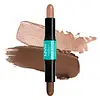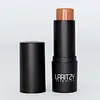What's inside
What's inside
 Key Ingredients
Key Ingredients

No key ingredients
 Benefits
Benefits

 Concerns
Concerns

 Ingredients Side-by-side
Ingredients Side-by-side

Ethylhexyl Palmitate
EmollientCetearyl Ethylhexanoate
EmollientHydrogenated Polyisobutene
EmollientIsodecyl Neopentanoate
EmollientDimer Dilinoleyl Dimer Dilinoleate
EmollientSynthetic Wax
AbrasivePolyglyceryl-2 Triisostearate
EmulsifyingCera Microcristallina
Emulsion StabilisingEuphorbia Cerifera Cera
AstringentHydrogenated Castor Oil
EmollientRicinus Communis Seed Oil
MaskingTin Oxide
AbrasiveTocopherol
AntioxidantTocopheryl Acetate
AntioxidantPhenoxyethanol
PreservativeEthylhexyl Palmitate, Cetearyl Ethylhexanoate, Hydrogenated Polyisobutene, Isodecyl Neopentanoate, Dimer Dilinoleyl Dimer Dilinoleate, Synthetic Wax, Polyglyceryl-2 Triisostearate, Cera Microcristallina, Euphorbia Cerifera Cera, Hydrogenated Castor Oil, Ricinus Communis Seed Oil, Tin Oxide, Tocopherol, Tocopheryl Acetate, Phenoxyethanol
 Reviews
Reviews

Ingredients Explained
These ingredients are found in both products.
Ingredients higher up in an ingredient list are typically present in a larger amount.
Ethylhexyl Palmitate, also known as octyl palmitate, is created from 2-ethylhexyl alcohol and palmitic acid. It is a fatty acid ester.
The fatty acid content of Ethylhexyl Palmitate makes it an emollient. Emollients help soften and hydrate your skin by trapping moisture within.
Ethylhexyl Palmitate is also used to help improve the texture of cosmetics. It helps other ingredient dissolve in products and help disperse ingredients more evenly.
You'll likely find this ingredient in sunscreen, as it is often used to mix UV-blocking ingredients such as avobenzone and ethylhexyl triazone.
It can also help stabilize the fragrances in a product as a fragrance fixative.
Ethylhexyl Palmitate can be used to substitute mineral oil.
Due to its high fatty acid content, it may not be fungal-acne safe.
Learn more about Ethylhexyl PalmitatePhenoxyethanol is a preservative that has germicide, antimicrobial, and aromatic properties. Studies show that phenoxyethanol can prevent microbial growth. By itself, it has a scent that is similar to that of a rose.
It's often used in formulations along with Caprylyl Glycol to preserve the shelf life of products.